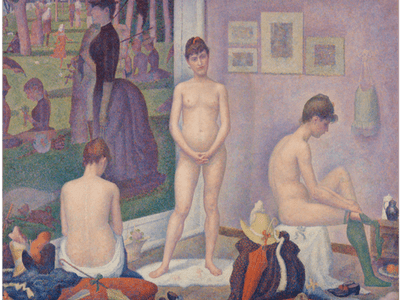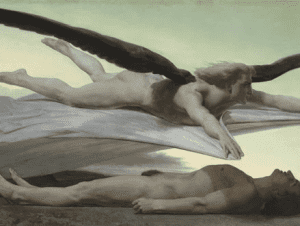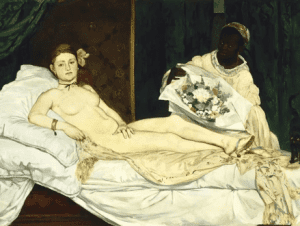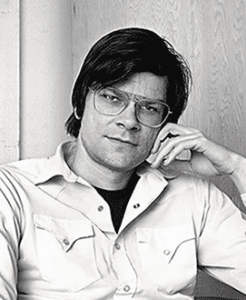Title of Artwork: “Models (Poseuses)”

Artwork by Georges Seurat
Year Created 1886–1888
Models (Poseuses) by Georges Seurat Canvas Print
Summary of Models (Poseuses)
Models pose in front of Seurat’s iconic pointillist painting, A Sunday on La Grande Jatte—1884 (1884-86; Art Institute of Chicago), in this studio interior scene. Many critics of the time viewed pointillism, which was informed by scientific theories of light, colour, and optics, as excessively cold and methodical, and therefore incapable of being applied to noble subjects like the nude. Seurat seems to respond here by showing full-size human bodies from different perspectives.
All About Models (Poseuses)
In his 1888 Salon des Independants debut, Models was Georges Seurat’s brash rebuttal to his detractors, in which he argued that his innovative neo-impressionist painting style, pointillism, could be successfully applied to one of the highest regarded and most virtuous themes in all of art: the naked body.
A Sunday on La Grande Jatte—1884, 1884–86, a scene of middle-class leisure that functioned as a colossal assertion of his aesthetic beliefs, having been displayed by him at the eighth and final impressionist exhibition two years prior.
Seurat, armed with knowledge of scientific theories of light, colour, and optics, meticulously arranged pure colour touches on his painting. The artist claimed that the combination of these colours resulted in a more vibrant overall effect.
Nonetheless, other reviewers argued that the landscape and atmospheric effects would benefit most from being shown using this complex network of brushstrokes.
Seurat’s latest “war canvas” (toile de lutte), as he called his most inflammatory manifesto paintings, prominently features the location La Grande Jatte, announcing the work’s connection to the controversy of 1886. Recognizing the difficulty of the task, Seurat accepted it by embracing and subverting art historical tradition in Models.
Genre scenes of models disrobing, posing, and dressing in a corner of the artist’s studio were commonplace at the yearly salon, and this work offers one such example, though on the grand scale of the great machines of history painting (mythological, historical, and religious subjects that occupied the pinnacle of the hierarchy of the genres).
While the story of Models is unclear, it is possible that the women in the film are “auditioning” for modelling jobs, with each scene being a rapid-fire commercial interaction that stands in stark contrast to the more lofty stories depicted in paintings of historical figures.
Nonetheless, Seurat was able to show off his own skill by depicting three different angles of a naked model, front, side, and rear, all in the name of a parade. To show the technique and artifice of painting, Seurat placed his models in front of La Grande Jatte on the studio wall to the left at the same time.
Seurat subverted genre norms by drawing heavily from academic and avant-garde elements from the antique, Renaissance, and 19th century that would have been immediately recognisable to critics and savvy viewers of the time.
Collectively, the three women evoke the ancient Three Graces (and Raphael’s depiction of the subject), but their separation, their modern bodies, and their reflective silence challenge conventional depictions of the subject, which typically feature three voluptuous figures linked in a graceful dance.
A painting by Edouard Manet titled Lunch on the Grass (Le Dejeuner sur l’herbe), 1863 (Musée d’Orsay, Paris) is a prime example of sarcastic borrowing.
In contrast to the right-hand figure, which is reminiscent of the antique Spinario, the model facing away from the observer is reminiscent of Bathing Woman, 1806, by Jean-Auguste-Dominique Ingres, a work which was added to the Louvre’s collection in 1879. The models in their signature stances connect the present and the past through the accumulated fashions and accessories at their feet.
Models (Poseuses) by Georges Seurat Framed Print
Information Citations:
En.wikipedia.org, https://en.wikipedia.org/.
Recommend0 recommendationsPublished in Art History, Artworks







Responses